
Ponticelli is an eastern suburb of Naples, southern Italy with a population of some 70,000 inhabitants.

Ponticelli is an eastern suburb of Naples, southern Italy with a population of some 70,000 inhabitants.
It is located inland, near the highway connections of the city; Barra lies to the south. Ponticelli end with San Giorgio a Cremano, Volla and Cercola. It is part of Comune di Napoli. The River Sebeto crossed the territory of Ponticelli till 1950, when it was covered. The area was humid and covered by water. Between 1930 and 1950 the land was urbanized.

The name comes from the medieval period, during which it was called Ponticello and it was divided in two parts: big Ponticello and little Ponticello. Only in 1947 it became a plural noun because of the union of the two sections.
Two ancient Roman villae rusticae were found in 1985, later excavated in 1987 and 2007. They were buried following the eruption of Vesuvius in 79 AD which led to a sudden abandonment of the villa by its inhabitants. One in via Decio Mure was completely unearthed and it was possible to recover a large part of the furnishings in use in the house at the time of the eruption. [1] This villa belonged to Caius Olius Ampliatus, [2] a descendant of a veteran of Sulla and was focussed on production of olive oil and wine. It was a farm divided into agricultural and urban parts.
With an area of at least 2000 sqm., it was centred on a colonnaded portico and with rooms distributed into production areas and residential parts. South of the porticoed garden are the rooms dedicated to agricultural processing. In addition to rooms for bread making, there are rooms for the production with a small press of olive oil in enough quantity for the inhabitants. In the same area are larger rooms for production of wine with a large press wine and large cellar with dolia. There was also tank for the fermentation of the must (lacus).
In the basement of this villa the skeleton of a man was found in a crouching position with his hands on his face no doubt surprised by the eruption. He had a ring with the seal of the owner fused on a finger (due to the temperature of the volcanic ash). He was aged forty, probably a slave, toothless (due to malnutrition) and with several fractures. This discovery on this side of Vesuvius was important in showing that the eruption of 79 included not only rain of ash and lapilli, but also the pyroclastic flow at a temperature of 500 °C leading to burning of the skull and possible liquefaction of the brain.
During the mediaeval period, in particular during the first part of the XIII century, there was the construction of a basilica in Ponticelli which is the Basilica Santuario di Santa Maria della Neve.
The area was incorporated into the city of Naples under Fascist rule and was heavily bombed in World War II. The area has suffered much the same fate of urban decay as the rest of the eastern periphery of Naples, a fate that includes drugs, entrenched organized crime, unemployment, massive overbuilding since the end of World War II and a large influx of illegal immigrant workers. The quarter of Ponticelli was the first to revolt against the Nazis, starting the Four days of Naples. Radio London gave the first notice of the riots. The riot ended with the arrival of Nazi troops. After the war, the city was known as "borgo rosso" since the high percentage of vote given to Communist party.
The entrance has two lintels that still bear the signs of the hinges of a double-leaf door, closed at night by a horizontal iron rod. The road which this gate faced was the confluence of those from Herculaneum and Nola.
There was a large dining room with a window overlooking Mount Vesuvius, while behind it was an internal vegetable or decorative garden.
A central portico divided the residential area from the productive one where it met the oletum, the area for pressing olives, as evidenced by the remains of a millstone. The farmyard overlooked a large field that, at the time of the eruption, was probably used as a pasture or had been damaged due to the numerous earthquakes before the eruption.
The pistrinum was rather small and contained an oven, suitable for baking bread only for the family, and a millstone in volcanic stone formed in the lower part by a conical part below and in the upper part by a biconical part where the grain was inserted to be ground.
The wine cellar, which in ancient times had a roof, includes numerous dolia, terracotta containers of various sizes designed to ferment the wine and in such a number that the presence of a vineyard can also be hypothesised.
Ponticelli is also famous for a religious feast: the Feast of Madonna della Neve. It is celebrated on August fifth because it is said that in 1988 it snowed on that day. It incorporates a wagon with a statue of the Madonna on it; every fifty years people put the golden Madonna on a wagon. Many people do it for a sense of devotion, while others take part in the feast only to have visibility in the suburb. The procession of the wagon happens on the first Sunday after the fifth of August; if the fifth of August happens on a Sunday, the procession is on that day. During the festivity day, the wagon goes around Ponticelli to bless all the families and all the houses. When the Madonna arrives back at the church, people listen to mass and then sing a song called "Goodnight Mary", during which people wave white napkins as a mark of respect for the Madonna.
Ponticelli is an inner city area, but there are a lot of people who try to raise up the quartier. In particular, there are some murals which depict social and cultural problems, like 'O scior cchiù felice made by Fabio Petani or Ael. Tutt'egual song 'e criature made by Jorit.

A Roman villa was typically a farmhouse or country house in the territory of the Roman Republic and the Roman Empire, sometimes reaching extravagant proportions.

Torre del Greco is a comune in the Metropolitan City of Naples in Italy, with a population of c. 85,000 as of 2016. The locals are sometimes called Corallini because of the once plentiful coral in the nearby sea, and because the city has been a major producer of coral jewellery and cameo brooches since the seventeenth century.

The Villa of the Papyri was an ancient Roman villa in Herculaneum, in what is now Ercolano, southern Italy. It is named after its unique library of papyri, discovered in 1750. The Villa was considered to be one of the most luxurious houses in all of Herculaneum and in the Roman world. Its luxury is shown by its exquisite architecture and by the large number of outstanding works of art discovered, including frescoes, bronzes and marble sculpture which constitute the largest collection of Greek and Roman sculptures ever discovered in a single context.

Castellammare di Stabia is a comune in the Metropolitan City of Naples, Campania region, in southern Italy. It is situated on the Bay of Naples about 30 km (19 mi) southeast of Naples, on the route to Sorrento.
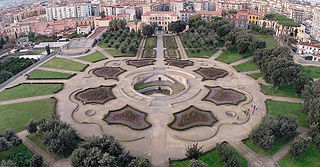
San Giorgio a Cremano is a primarily residential town and comune in the Metropolitan City of Naples, in Italy. It is located on the foothills of Mount Vesuvius to the west of the volcano, and is five kilometres to the south east of the centre of Naples. Most parts of the municipality command views of Mount Vesuvius, Mount Somma and the Bay of Naples.
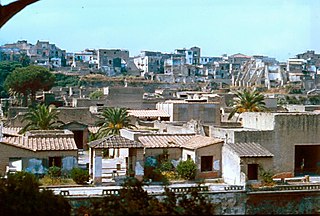
Ercolano is a town and comune in the Metropolitan City of Naples, Campania of Southern Italy. It lies at the western foot of Mount Vesuvius, on the Bay of Naples, just southeast of the city of Naples. The medieval town of Resina was built on the volcanic material left by the eruption of Vesuvius that destroyed the ancient city of Herculaneum, from which the present name is derived. Ercolano is a resort and the starting point for excursions to the excavations of Herculaneum and for the ascent of Vesuvius by bus. The town also manufactures leather goods, buttons, glass, and Lacryma Christi wine.

The Villa Poppaea is an ancient luxurious Roman seaside villa located in Torre Annunziata between Naples and Sorrento, in Southern Italy. It is also called the Villa Oplontis or Oplontis Villa A. as it was situated in the ancient Roman town of Oplontis.

Boscoreale is an Italian comune and town in the Metropolitan City of Naples, Campania, with a population of 27,457 in 2011. Located in the Vesuvius National Park, under the slopes of Mount Vesuvius, it is known for the fruit and vineyards of Lacryma Christi del Vesuvio. There is also a fine Vesuvian lava stone production.

The Villa of the Mysteries is a well-preserved suburban ancient Roman villa on the outskirts of Pompeii, southern Italy. It is famous for the series of exquisite frescos in Room 5, which are usually interpreted as showing the initiation of a bride into a Greco-Roman mystery cult. These are now among the best known of the relatively rare survivals of Ancient Roman painting from the 1st century BC.
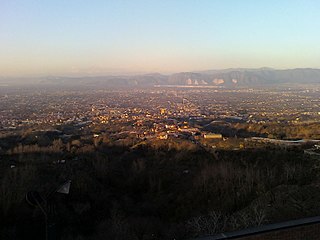
Somma Vesuviana is a town and comune in the Metropolitan City of Naples, Campania, southern Italy.

Bugnara is a comune and village in the province of L'Aquila in the Abruzzo region of southern Italy. It is a member of the I Borghi più belli d'Italia association.

Pollena Trocchia is a comune (municipality) in the Metropolitan City of Naples in the Italian region Campania, located about 11 km east of Naples.

Villa Boscoreale is a name given to any of several Roman villas discovered in the district of Boscoreale, Italy. They were all buried and preserved by the eruption of Mount Vesuvius in 79 AD, along with Pompeii and Herculaneum. The only one visible in situ today is the Villa Regina, the others being reburied soon after their discovery. Although these villas can be classified as "rustic" rather than of otium due to their agricultural sections and sometimes lack of the most luxurious amenities, they were often embellished with extremely luxurious decorations such as frescoes, testifying to the wealth of the owners. Among the most important finds are the exquisite frescoes from the Villa of Publius Fannius Synistor and the sumptuous Boscoreale Treasure of the Villa della Pisanella, which is now displayed in several major museums.
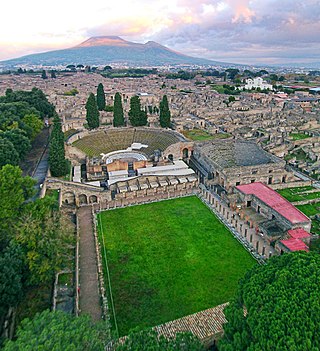
Pompeii was an ancient city located in what is now the comune of Pompei near Naples in the Campania region of Italy. Pompeii, along with Herculaneum and many villas in the surrounding area, was buried under 4 to 6 m of volcanic ash and pumice in the Eruption of Mount Vesuvius in 79 AD.

Stabiae was an ancient city situated near the modern town of Castellammare di Stabia and approximately 4.5 km southwest of Pompeii. Like Pompeii, and being only 16 km (9.9 mi) from Mount Vesuvius, this seaside resort was largely buried by tephra ash in 79 AD eruption of Mount Vesuvius, in this case at a shallower depth of up to 5 m.
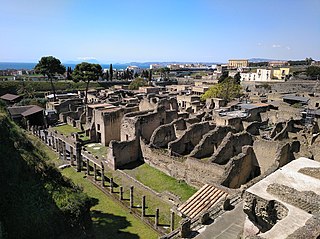
Herculaneum was an ancient Roman town, located in the modern-day comune of Ercolano, Campania, Italy. Herculaneum was buried under volcanic ash and pumice in the Eruption of Mount Vesuvius in 79 AD.

The following is a timeline of the history of the city of Naples. The Naples area has been inhabited since the Neolithic period. The earliest historical sources in the area were left by the Myceneans in the 2nd millennium BC. During its long history, Naples has been captured, destroyed and attacked many times. The city has seen earthquakes, volcanic eruptions, foreign invasions and revolutions.
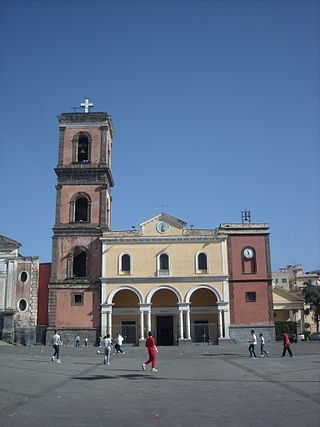
The Basilica of Santa Maria a Pugliano is the main church in Ercolano and the oldest church in the area around Mount Vesuvius.
The Aprea-Cuccaro clan is a Camorra clan operating in the area of Barra, in the city of Naples.
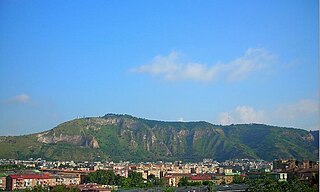
The Camaldoli hill is the highest point in the city of Naples, with a maximum altitude of 457 meters above sea level. It extends between the municipality of Naples and the municipalities of Marano di Napoli and Quarto. The hill is estimated to be about 35,000 years old and to have formed from violent volcanic eruptions in the Phlegraean Fields.